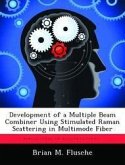The operation of a 14-channel five stage electro-optic beam steering device was studied. Beam deflection scanned from 0 degrees to 10.1 degrees was demonstrated. The maximum angle is within 0.3% of design. Many laser systems in operation today implement mechanical beam steering methods that are often expensive in terms of cost, weight and power. They are slow and subject to wear and vibration. A non-inertial beam scanning mechanism, such as one based on the device studied in this research could enhance the performance of these systems. The device studied here is fabricated in LiTaO3 using micro-patterned domain reversal. The 14 channels allow for steering large aperture beams while the five cascaded stages increase the total deflection angle. The steering mechanism is a series of prisms created through domain reversal with the index change across prism interfaces controlled electro-optically. The maximum coupling efficiency achieved was 61.6% for this device. Also, the far-field observations revealed a pattern consistent with a beam diffracted through a multi-slit aperture. Forbidden angles exist between modes caused by destructive interference regardless of the applied voltage. A discussion on a method to improve device design, which allows the forbidden angles, is presented.








